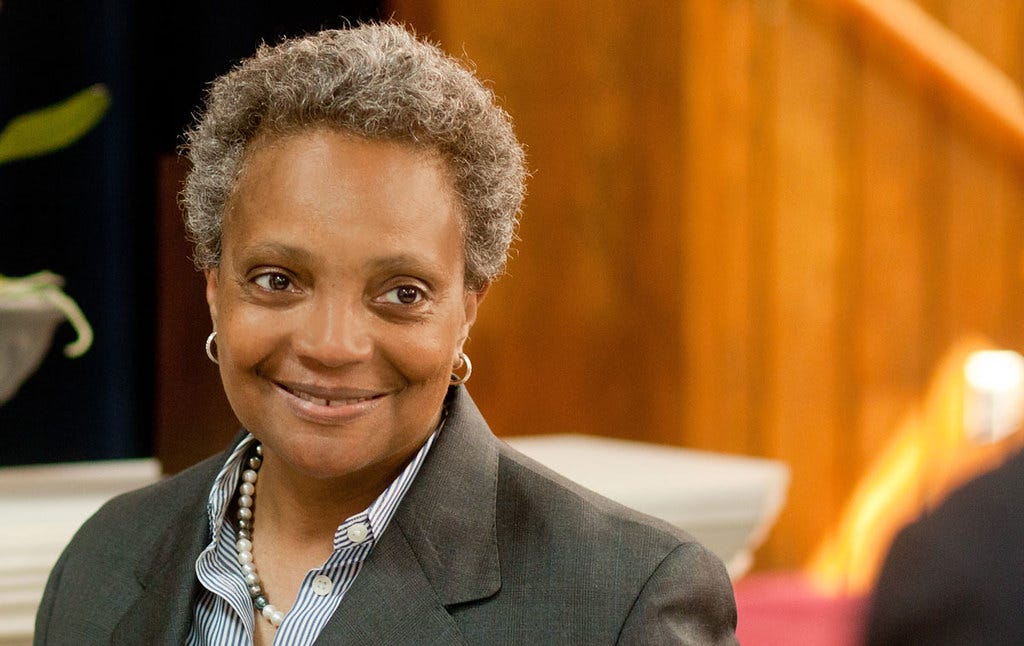Want to Interview Mayor Lightfoot? We'll Have to Check Your Skin Color First.
On the Chicago mayor's illiberal initiative to grant exclusive access to journalists of color
On May 19, to celebrate the second anniversary of her inauguration, Chicago Mayor Lori Lightfoot announced that she would be giving one-on-one interviews only with “journalists of color” for the day.
The news came in a letter, addressed to City Hall reporters, that criticized the “overwhelming whiteness and maleness of Chicago media outlets, editorial boards, the political press” and the “City Hall press corps specifically.” The mayor’s letter continued for two pages, alternately swiping at the media’s lack of diversity and congratulating herself for the demographic variety present among her own staff.
There was a lot wrong with what Mayor Lightfoot did, though evidently she thought it was not just problem-free but actively praiseworthy. It must have come as a surprise when backlash included, among many others, Latino Chicago Tribune reporter Gregory Pratt, who said he had ethical objections to any politician choosing who covers her, and these don’t disappear with an identitarian gloss.
Worse, the mayor’s grandstanding and self-defeating letter was simply untrue. It claimed that “there are zero women of color assigned to the City Hall beat. Zero.” But two of WBEZ Chicago’s three City Hall reporters are women of color. It’s a bad sign that Lightfoot’s administration is either unable to gather basic facts or purposefully disregarded them to make a point. Chicago needs competent and honest leadership to help solve its many endemic problems—violence and poverty topping the list. This was neither honest nor competent.
The bigger concern, however, is the belief that open racial discrimination is acceptable, even admirable, as long as it’s in the right direction. This is nothing new, as anybody who follows American politics knows. It’s a belief that has gained a lot of purchase on the left, often smuggled in via misnomers like “antiracism” and “equity,” which are radical ideas given banal or positive associations because their names are political euphemisms.
If you read the mayor’s letter—which deliberately uses similar ideologically tinged terms including ‘systemic racism’, ‘Latinx’, ‘implicit bias’, (capital b) ‘Black’, and (lower-case w) ‘white’—it’s clear that Lightfoot has adopted certain terms and concepts from the identitarian left that prescribe forms of racial discrimination. As “antiracism” guru Ibram X. Kendi put it, “the only remedy to past discrimination is present discrimination.” Lightfoot’s conditions for being interviewed—that only “journalists of color” would be considered—is the praxis of that theory in a particular context.
Lightfoot implicitly argues that the racial disparity in the Chicago press corps should be addressed by discrimination and that, in this case, racial bias is laudable because it is aimed at achieving equity. Many journalists rightly found Lightfoot’s condition for being interviewed unethical.
But it was more than that. The mayor’s decision to restrict journalists’ access based on their skin color was an attack on liberalism itself, which demands a free, uncensored press. In her letter, Lightfoot argued that, due to the press corps’ lack of diversity, “this arm of our democratic system is on life support.” This suggestion, that restricting press access based on race will help revive a failing media, would be laughable if it wasn’t so dangerous.
Elected officials should not be micromanaging which journalists or press outfits can cover them. In any context outside of race and identity, this claim would be evident to both the left and the right. But the left has become so uncritically accepting of racialized culture and politics that, for them, racial identitarianism ends up trumping fundamental liberal principles.
Elected officials should not be filtering access based on race—even for a single day. The purpose of interviewing powerful politicians is to hold them to account and inform the public; a journalist’s race should have nothing to do with that.
The most concerning part of Lightfoot’s letter comes at the end. There, she writes that “If the answer to these questions [about efforts to diversify newsrooms] is no, be advised that I will continue to press for that to change.” That not-so-veiled threat indicates that Lightfoot’s interview policy may not be a one-off and that more initiatives to reshape personnel in newsrooms may be on their way.
The attempt to bully and control journalists violates a basic norm of liberal democratic societies. That’s why, for example, it’s an important tradition to let even some of the fringy outlets into the White House press pool. Politicians have favorites, of course, but they are not supposed to play favorites with the press. They are especially not supposed to tell journalists who gets to cover them.
In her enthusiasm for racial diversity, Lightfoot seems to have stumbled into a violation of liberal civic norms. Now that even journalists of color have pointed out that it was a bad idea, not a good-natured progressive action, she ought to be aware of the problem and refrain from pursuing it further.
If it is true that, as Lightfoot says in her letter, “equity and inclusion are the north stars” of her administration, she should retract her threat to the independent press and get back to managing her own office and the city she was elected to run.


